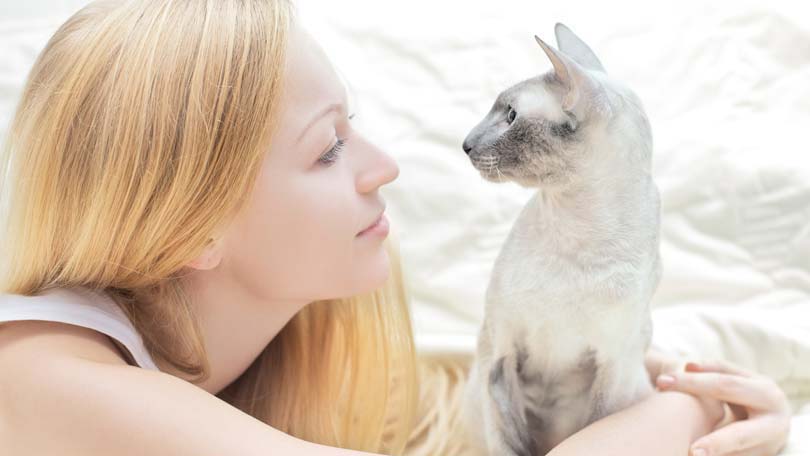
Most pet owners love the soft sound of their cat purring. What is better than feeling the muted vibration of your cat’s body as he expresses his contentment at your petting him or scratching behind his ears? Many think they know the answer to the question “why do cats purr?” But happiness isn’t the only emotion that can inspire purring.
Before discussing why cats purr, let’s take a look at how cats purr. Most creatures have a way of expressing happiness. For humans it is laugher or, perhaps, a contented sigh. For canines a good tail wagging is the best way to express joy. Cats also have a way to express happiness and other emotions: by purring. But how, exactly, does it happen?
The most popular scientific explanation involves communication between the brain of the cat to the voice box. When the brain communicates happiness (or other emotions as will be discussed later), the muscles in the voice box begin to vibrate. As air passes through the vibrating muscles, it creates the sound we call purring.
Pet owners may have noticed that at times it seems the cat is purring without interruption. That is because the sound is created both when air is inhaled and when air is exhaled, so the sound is continuous. You may notice if your cat increases the rate of his breathing, the purring may become louder or more distinct. That, too, is related to the air flow past the vibrating muscles.
A second theory is that purring is related to the release of endorphins in the brain. Since cats purr both when happy and during times of stress or pain, this theory is attractive to many experts.
Now that you have learned two of the popular theories about how cat’s purr, let’s talk more about why they purr.
Kittens begin to purr within a day or two after birth. Purring is thought to be, in part, a form of communication between felines. This earliest purring, by both mother cat and her kittens, may be part of the initial bonding process. The sound of the purring changes as a kitten grows into a mature cat, but there is no way to know if the meaning changes.
Pet owners know for sure that most cats purr when they are happy or content. Give a cat a good belly rub and you will likely be able to hear him purring from across the room. Some cats purr while they are eating, perhaps indicating their contentment at having enough food.
What some pet owners may not know is that cats also purr during some of the not so happy moments in their lives. Many cats purr when they are very close to death. Perhaps this is due to anxiety or any pain that they may be feeling at that moment. Others think that the purring at the time of death is related to euphoria, not anxiety. Of course, there is no test that can determine that for sure, so experts will likely continue to disagree.
Cats also purr when they are very ill. Is this because of the pain they may feel? Some say yes, while others believe that the purring is a way that the cat tries to calm himself. Have you ever been in pain or under a great deal of stress and found some comfort by singing to yourself? Some think that is why cats purr during difficult times in their lives. Of course, if the second theory about how cat’s purr is true, that would make sense, because the brain releases endorphins during times of pain and stress.
Frightened cats also purr. The reason could be to show submission to an enemy or to communicate friendliness to another animal. It could also be a way to let other creatures know that the cat has no intention of acting aggressively towards them.
When a cat approaches another cat to play or interact, the cat often purrs. This could be the cat’s way of communicating his reason for approaching.
Giving birth is another time when many cats become very vocal. As in many other areas regarding purring, there is debate as to why a mother cat purrs during delivery. Some say that it is joy at giving birth. More common is the theory that purring during labor helps a cat deal with the pain and the stress of the birthing process. If purring during labor is to deal with the pain, perhaps the joy comes a bit later. Mother cats also often purr loudly when nursing her kittens.
It is also common for cats to purr while sleeping. Because it is not a big secret that cats enjoy their naps, it is a pretty safe bet that if an emotion is involved with sleep purring, it is joy or contentment rather than stress!
Because they purr while being petted, cats seem to provide an instant and very visible means of communicating that they are happy with your efforts. For this reason, some cats make wonderful therapy animals. Cats that have been specially trained and certified as therapy animals visit hospitals, nursing homes and other facilities. They visit with the patients, often by curling up in their laps for a nice session of petting and purring.
Studies have shown that such interaction with therapy cats can lower blood pressure and help to alleviate depression in some patients. While there are not studies that have proven the purring is the reason for the lowered blood pressure or other positive effects, it certainly can’t hurt.
Of course, answering the question “why do cats purr?” is not as important to some pet owners as the fact that they DO purr. They purr at the sad and stressful times in their lives but, more importantly, they purr in response to your show of affection to them. What could be better than that?





